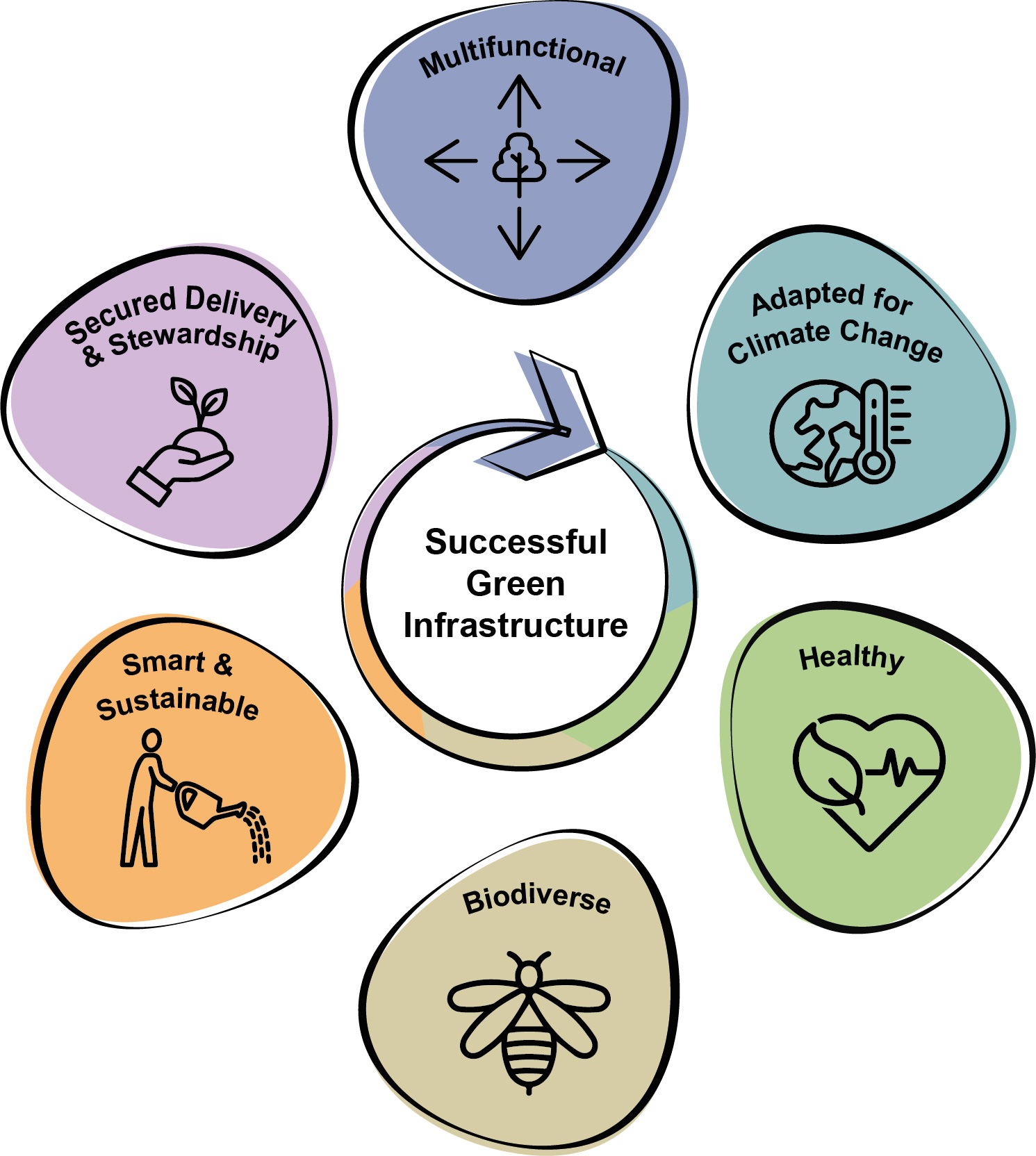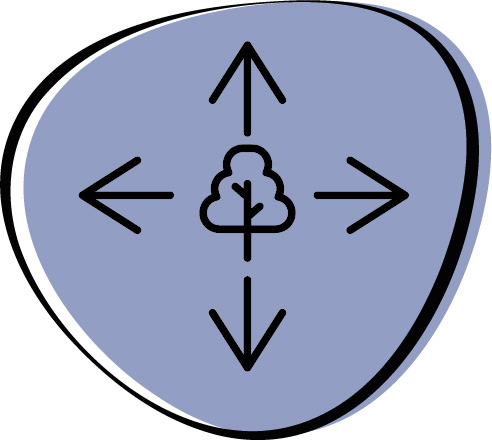At the heart of all good GI is multifunctionality. All GI should be multifunctional and deliver a range of ecosystem services to support biodiversity, climate targets, health and wellbeing and economic prosperity.
Introduction
The Green Infrastructure (GI) Settlement Management Plans integrate and update current thinking and initiatives presented within the Pembrokeshire GI Action Plan (now superseded).
Each of the 11 Settlement Management Plans provide a streamlined approach to the identification and delivery of GI interventions. Their aim is to help policymakers, developers, community groups and residents to deliver appropriate, multifunctional and resilient GI across 11 settlements in Pembrokeshire.
Within each Settlement Management Plan, a long list of projects has been identified through public consultation, stakeholder consultation, site visits and professional judgement. The long list provides a variety of project types, scales and costs, and is intended to be taken forward by various partners as and when funding becomes available. By delivering a diversity of projects, the variety of benefits and ecosystem services experienced across each settlement will grow.
Three ‘kickstarter’ projects have been selected from this long list for each settlement. These three projects are intended as GI exemplars and should be put forward first for delivery. It is hoped that the delivery of these kickstarter projects should get the ball rolling for GI within each settlement, and also help to build public and stakeholder appetite for future projects. For each settlement, one of the three kickstarter projects relates to the water environment, highlighting the need for natural flood management and nature-based solutions to water quality across Pembrokeshire.
The rationale for identifying the kickstarter projects included:
- Popularity with the public
The public were asked to rate their favourite projects through an online survey. The more popular projects for each settlement were reviewed and given priority. - Multifunctionality and range of benefits
Projects that provide multiple benefits and align with a number of the GI principles (see below) were put forward. - Timescales
A range of timescales, including quick win, medium-term and long-term projects, were put forward to allow for a variety of scales, delivery mechanisms and aspirations to be met. - Deliverability
Projects that were deemed to be ‘more deliverable’ were put forward, for example, being located on Council-owned land, relating to a clear funding stream, or aligning with existing community group aspirations. - Professional judgement
The finalised list of ‘kickstarter’ projects was compiled using professional judgement to ensure the above criteria provided a multifunctional and representative list of projects to be taken forward first.
The Urban Tree Planting and Pollinator Strategies are supplementary to the Settlement Management Plans and should be read in conjunction with the Plans. Their role is intended to provide additional guidance when delivering urban tree planting or pollinator-related projects.
All GI projects should be developed to ensure consistency with active travel proposals included on the Integrated Network Maps (INMs) for Pembrokeshire.
Green Infrastructure Principles
A series of GI Principles have been developed which apply to all GI across Pembrokeshire, therefore spanning all 11 Settlement Management Plans. The principles are based on Natural Resources Wales’ ‘5 Principles of GI’, which have been created to ensure well-designed GI provides a range of benefits for both people and wildlife alike. An additional principle ‘Successful delivery’ has been included to ensure that good quality ideas and designs are taken forward and their longevity secured through well-planned stewardship arrangements. These six overarching principles have been broken down into sub-principles to provide more guidance on the specific design and delivery of good quality and successful GI across Pembrokeshire.


1. Multifunctional
Ensure all GI across Pembrokeshire is delivering as many benefits as possible.
GI should be varied and deliver a mixture of asset types, including both habitats and recreation. This should also be coupled with its delivery at a variety of scales.
GI should respond to its local context and contribute towards a distinct sense of place, particularly when located within the Pembrokeshire Coast National Park. It should take account of landscape character, key views, native species, habitats and current land use.

2. Adapted for climate change
Ensure all GI is delivering both climate change mitigation and adaptation.
All GI should contribute towards the removal and long-term storage of carbon from the atmosphere, to some extent.
GI should help contribute towards reducing the reliance on personal vehicles and instead encourage active lifestyles.
All GI should provide some opportunities for natural flood management, including from fluvial, marine, groundwater and surface water sources.
GI proposals should be adaptable and resilient to move with the changing pressures of climate change. GI should be designed with future climate change projections in mind.

3. Healthy
Ensure all GI is contributing towards the creation of physically and mentally healthier communities.
GI should be designed inclusively for all demographics, regardless of age, gender, maternity, ethnicity and physical or mental ability. All green spaces should respond to the needs of less mobile users and forgotten demographics, such as teenage girls or those with dementia. Green spaces should feel safe for all and connect different communities.
GI should be used as a tool for investment and therefore be included as a key part of any regeneration plans.
Green space and GI should always be designed to allow for some interactions with nature, no matter how small, as well as filling gaps of green space deficiency.
Community gardens, edible corridors and sustainable local food growth should be promoted for its mental and physical health benefits, as well as the positive impacts it can have on wildlife and community cohesion.
Where poor air quality is identified, GI should be utilised as a nature-based solution to the removal of particulates alongside reducing reliance on polluting modes of transport.

4. Biodiverse
Ensure all GI is supporting a variety of native species in providing opportunities for food, shelter and movement.
GI projects should, first and foremost, work to protect and enhance existing important biodiversity assets, including designated habitats and notable species. Helping struggling wildlife communities and habitats in poor condition to recover should be a priority.
GI of all scales should be used to help connect habitats and reduce fragmentation. This should include restoring and re-connecting linear habitat features, including road verges, riparian corridors and hedgerows. Work with local landowners and farmers to promote this, alongside emerging agri-environment schemes.
Section 6 of the Environment (Wales) Act 2016 places a general duty on public authorities to, “seek to maintain and enhance biodiversity in the exercise of functions… and in so doing promote the resilience of ecosystems”. The Nature Recovery Action Plan for Pembrokeshire sets the strategic context for actions to protect and enhance biodiversity and ecosystems in the county.
GI’s ability to deliver nature-based solutions to water quality should always be explored, for example through wetlands adjacent to combined sewer overflow, SuDS and riparian buffers. However, controlling water quality at the source of the problem should always be the priority.
GI design should utilise native species, particularly those of local provenance. It should always align with local habitat and species needs, as well as always exploring options for pollinators.

5. Smart and sustainable
Ensure all GI is as low maintenance as possible, whilst reducing pollution and maximising sustainably sourced materials.
GI should be designed to ensure it is low maintenance and that these straightforward management solutions will continue to deliver the GI asset’s intended benefits. Management needs to be long-term and secured from the outset of a project, for example through engaging with communities.
Materials and street furniture used within GI design, for example, benches and signage, must use sustainably sourced and naturalistic, yet robust.

6. Secured delivery and stewardship
Ensure all GI projects have their successful delivery and long-term stewardship secured from the outset.
Include all demographics of the local community within the co-design and co-planning of a GI project, ensuring areas of the greatest need are prioritised first. Where possible, community ownership should be explored.
Alongside citizens, include all appropriate landowners, businesses, developers, environmental groups, local authorities, council members and officers, statutory and non-statutory consultees, utility companies, and those responsible for the management of GI assets, within the planning, designing, delivery and ongoing stewardship of GI. Ensure all parties are aligned with the shared vision and kept up to date with progress.
Due to the historic fabric of the settlements, it is recommended that early consultation with Cadw, Dyfed Archaeological Trust (DAT), landowners and occupiers is undertaken to understand the key historic environment considerations of individual sites. GI Projects should ensure that proposals do not result in detrimental impacts on heritage assets, including adverse changes to the settings of scheduled monuments or conservation areas.
Due to a number of the settlements being located within or adjacent to the Pembrokeshire Coast National Park, it is recommended that early consultation with Pembrokeshire Coast National Park Authority is undertaken. This also applies to Natural Resources Wales due to the significant number of national and international ecological designations both within and adjoining all settlements.
Ensure all parties involved, including stakeholders and the community, understand the benefits of the project, both qualitative and quantitative. This could also form the baseline for ongoing monitoring and measuring whether projects are as successful as first thought.
Ensure GI is integrated across a diversity of planning hooks, including in the Local Development Plan, subsequent Supplementary Planning Guidance, health strategies, climate change strategies, and economic or regeneration plans.
When planning GI interventions, consider how ongoing monitoring of the asset will be undertaken and how this data will be used to recognise successes or shortfalls.
